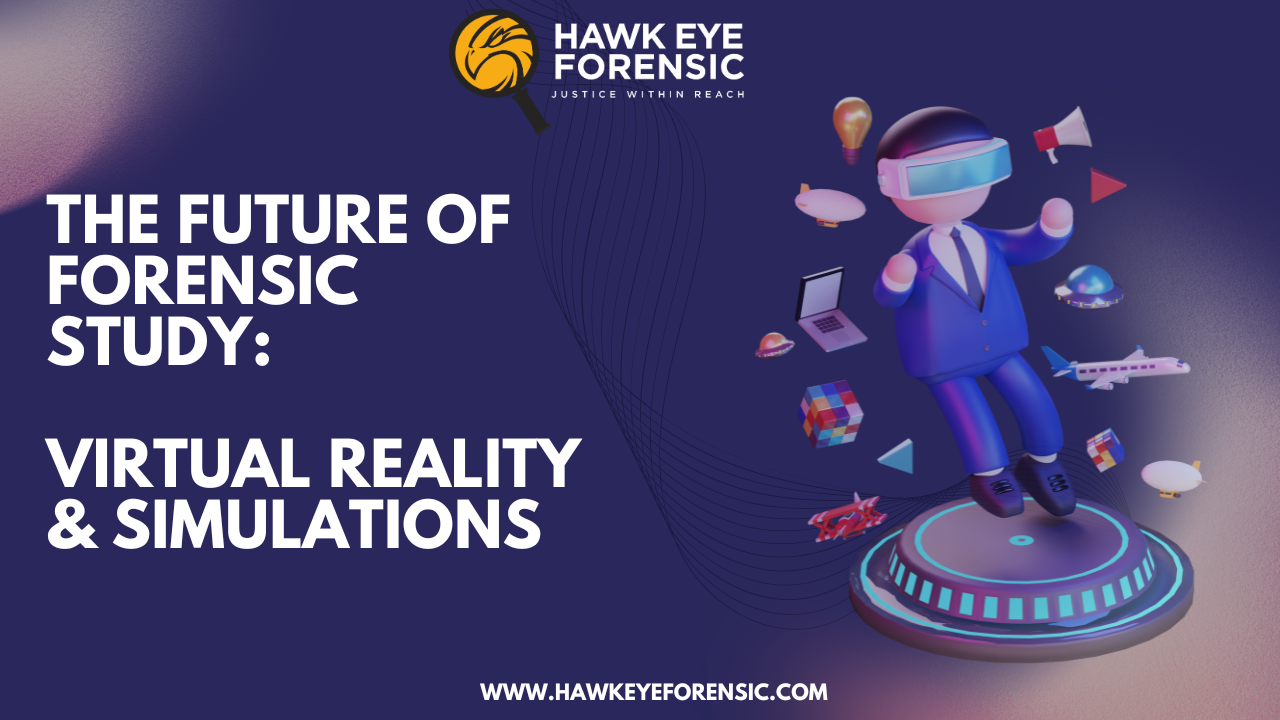
Introduction to SIM Card Forensics
Subscriber Identity Module, or SIM, is the acronym for a small, portable memory chip that stores data about a mobile phone user is SIM, or subscriber identity module. This information, ...


Digital Forensics todayFebruary 21, 2024

The integration of virtual reality (VR) and simulations has brought about a significant change in the field of forensic science, which is vital in solving crimes and delivering justice. These technological developments provide forensic investigators with previously unavailable resources to improve their training programs, optimize their techniques, and reconstruct crime scenes with unbeatable accuracy. In this blog, we explore the profound effect of virtual reality and simulations on forensic study, examining the benefits, challenges, and future implications of these immersive technologies.
Crime scene reconstruction is one of the most significant uses of virtual reality in forensic investigations. Conventional techniques for recreating crime scenes frequently depend on pictures, drawings, and actual models. These techniques, however, are not as good at capturing the scene’s scale, depth, and dimensional connections. Investigators may virtually walk through crime scenes and examine details from various angles thanks to virtual reality, which offers a dynamic and fascinating platform.
Using virtual reality headsets, forensic experts can view and manipulate three-dimensional reconstructions, facilitating a more precise evaluation of the arrangement of evidence and the general dynamics of the scene. Such a level of immersion helps investigators get an in-depth understanding of the crime scene and may provide information not seen in traditional reconstruction techniques.
Forensic investigations demand a high level of expertise, attention to detail, and the ability to analyze complex scenarios. Virtual reality has emerged as a valuable tool in forensic training programs, providing a simulated environment where investigators can refine their skills in an organized and realistic setting.
VR simulations allow trainees to practice evidence collection, crime scene analysis, and forensic procedures in a risk-free environment. From examining bloodstains to conducting digital forensics on virtual devices, these simulations offer a hands-on experience without the potential consequences of mistakes in real-world investigations. The immersive nature of VR facilitates a more engaging and effective learning process, accelerating the development of expertise among forensic professionals.
As the world becomes increasingly digitized, the role of digital forensics has become important in solving cyber crimes and addressing digital evidence. Virtual reality simulations in digital forensics create a bridge between the physical and virtual worlds, enabling investigators to navigate through digital environments with unmatched realism.
In a virtual setting, forensic experts can simulate scenarios involving hacking, data breaches, and other cybercrimes. This allows them to develop and refine their skills in identifying digital evidence, tracing virtual footprints, and analyzing complex cyberattacks. The dynamic nature of virtual environments reflects the ever-evolving landscape of cyber threats, providing a realistic training ground for digital forensic professionals.
Simulations in digital forensics extend beyond individual training to include collaborative exercises. Virtual reality platforms enable forensic teams to conduct coordinated investigations, even if members are geographically dispersed. By immersing themselves in a shared virtual space, team members can work collaboratively on the analysis of digital evidence, brainstorm strategies, and simulate real-time responses to cyber incidents.
This collaborative aspect of virtual reality simulations enhances communication among forensic teams, leading to a more integrated and efficient approach to digital investigations. The ability to share insights and observations within a virtual environment can significantly impact the speed and accuracy of resolving cybercrimes.
Although there are many advantages to using virtual reality and simulations in forensic investigations, it’s important to be aware of the challenges and factors involved.
The implementation of virtual reality systems, including hardware such as VR headsets and software development, can be a significant investment. High-quality VR equipment may be prohibitively expensive for some forensic laboratories or educational institutions, limiting general accessibility. Addressing cost barriers is crucial to ensuring that the benefits of virtual reality are available to a broader range of forensic professionals and students.
The effectiveness of virtual reality in forensic studies is dependent on the technology’s ability to accurately replicate real-world scenarios. Technical limitations, such as graphical clarity, motion tracking precision, and the level of detail in virtual environments, can impact the realism of simulations. Striking the right balance between technical capabilities and realism is a continuous challenge in the development of virtual reality applications for forensic science.
Virtual reality should complement, rather than replace, traditional forensic methodologies. Achieving a seamless integration between virtual reality tools and established forensic practices requires careful consideration of how these technologies can enhance, validate, or supplement existing approaches. Overcoming resistance to change and ensuring that virtual reality becomes a complementary asset in forensic investigations are vital considerations.
The rapid evolution of virtual reality technology holds promising prospects for the future of forensic studies. Improvements in hardware, such as more immersive headsets with higher resolution and better motion tracking, will contribute to enhanced realism in virtual crime scene reconstructions and simulations.
Additionally, the integration of haptic feedback and tactile sensations in virtual reality systems could further elevate the level of immersion for forensic investigators. The ability to physically interact with virtual evidence, mimicking the tactile experience of handling real-world objects, could bridge the gap between the virtual and physical realms.
The combination of artificial intelligence (AI) and virtual reality represents a frontier with transformative potential in forensic studies. AI algorithms can analyze vast amounts of data, identify patterns, and assist forensic experts in decision-making. Integrating AI-driven analytics with virtual reality simulations could create a powerful combination, enabling investigators to explore data visualizations, simulate forensic scenarios, and receive real-time insights within a virtual environment.
As virtual reality technology becomes more affordable and accessible, its integration into forensic education is likely to expand. Virtual reality simulations could become standard components of forensic science education, providing students with hands-on experience in crime scene investigation, evidence collection, and digital forensics. This approach not only enhances the educational experience but also contributes to the development of a highly skilled and adaptable forensic workforce.
A new age in forensic studies has been brought about by virtual reality and simulations, which have changed the way investigators approach training, evidence analysis, and crime scene reconstruction. The immersive nature of virtual reality offers a unique opportunity to bridge the gap between theory and practicality, providing forensic professionals with realistic and dynamic environments to enhance their skills.
Even though there are still obstacles, new applications, and continuous technological development are paving the way for the day when virtual reality is widely used in forensic investigations. As the integration between artificial intelligence and virtual reality develops, the potential for more accurate, efficient, and collaborative forensic studies holds great promise for the hunt for justice in the digital age. The virtual frontier has opened, allowing forensic experts to investigate and navigate crime scenes in ways that were previously beyond imagination, ultimately contributing to a more informed and effective criminal justice system.
Tagged as: Graphical fidelity, Digital forensics, Advance training, Motion tracking precision, Digital evidence, Advance methodos, Haptic feedback, Hands-on experience, Immersive technologies, Tactile sensations, Crime Scene Investigation, VR headsets, Artificial intelligence, Cyber Forensics, Spatial relationships, Data visualizations, Cybercrimes, Evidence placement, Forensic education, Crime scene Reconstruction, Blood spatter patterns, Integration, Evidence Collection, Digital crimes, Innovation, Virtual reality, Real-world scenarios, Forensic Science, Hunt of justice, Simulations, Technical limitations, Training methodologies.

Mobile Forensic Anjali Singhal
Subscriber Identity Module, or SIM, is the acronym for a small, portable memory chip that stores data about a mobile phone user is SIM, or subscriber identity module. This information, ...

Digital Forensics Anjali Singhal
Digital Forensics Anjali Singhal / May 20, 2024
Introduction In the modern digital landscape, the threat of malware looms large over individuals, businesses, and governments alike. Malware, short for malicious software, encompasses a variety of harmful programs designed to disrupt, damage, or gain unauthorized access to computer systems. With cyber threats becoming more sophisticated, the field of malware forensic analysis has become crucial. ...
Copyright 2023 all rights reserved by Hawk Eye Forensic.
Post comments (0)